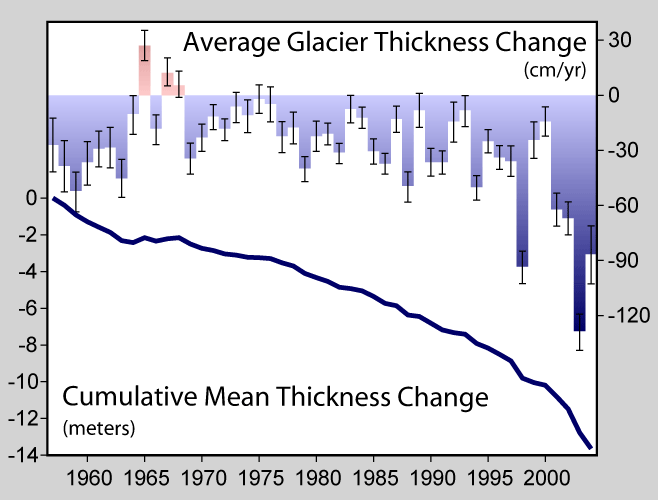Image:Glacier Mass Balance.png
From Wikipedia, the free encyclopedia

Glacier_Mass_Balance.png (658 × 500 pixel, file size: 24 KB, MIME type: image/png)
Description
This figure shows the average rate of thickness change in mountain glaciers around the world. This information, known as the glaciological mass balance, is found by measuring the annual snow accumulation and subtracting surface ablation driven by melting, sublimation, or wind erosion. These measurements do not account for thinning associated with iceberg calving, flow related thinning, or subglacial erosion. All values are corrected for variations in snow and firn density and expressed in meters of water equivalent (Dyurgerov 2002).
Measurements are shown as both the annual average thickness change and the accumulated change during the fifty years of measurements presented. Years with a net increase in glacier thickness are plotted upwards and in red; years with a net decrease in glacier thickness (i.e. positive thinning) are plotted downward and in blue. Only three years in the last 50 have experienced thickening in the average.
Systematic measurements of glacier thinning began in the 1940s, but fewer than 15 sites had been measured each year until the late 1950s. Since then more than 100 sites have contributed to the average in some years (Dyurgerov 2002, Dyurgerov and Meier 2005). Error bars indicate the standard error in the mean.
Other observations, based on glacier length records, suggest that glacier retreat has occurred nearly continuously since the early 1800s and the end of the little ice age, but variations in rate have occurred, including a significant acceleration during the twentieth century that is believed to have been a response to global warming (Oerlemans 2005).
- Further information: Retreat of glaciers since 1850
Data
These measurements are described in Dyurgerov (2002), updated in Dyurgerov and Meier (2005), and archived at the World Glacier Monitoring Service at the National Snow and Ice Data Centre.
Copyright
This figure was prepared by Robert A. Rohde from published data and is part of the Global Warming Art project.
This image is an original work created for Global Warming Art.
Permission is granted to copy, distribute and/or modify this image under either:
- The GNU Free Documentation License Version 1.2; with no Invariant Sections, Front-Cover Texts, or Back-Cover Texts.
- The Creative Commons Attribution-NonCommercial-ShareAlike License Version 2.5
Please refer to the image description page on Global Warming Art for more information
- http://www.globalwarmingart.com/wiki/Image:Glacier_Mass_Balance.png
References
- Dyurgerov, Mark B. (2002). "Glacier Mass Balance and Regime: Data of Measurements and Analysis". Institute of Arctic and Alpine Research, Occasional Paper 55.
- Dyurgerov, Mark B. and Mark F. Meier (2005). "Glaciers and the Changing Earth System: A 2004 Snapshot". Institute of Arctic and Alpine Research, Occasional Paper 58.
- J. Oerlemans (2005). "Extracting a Climate Signal from 169 Glacier Records". Science 308 (5722): 675 - 677.
File history
Legend: (cur) = this is the current file, (del) = delete this old version, (rev) = revert to this old version.
Click on date to download the file or see the image uploaded on that date.
- (del) (cur) 10:03, 29 July 2006 . . Dragons flight ( Talk | contribs) . . 658×500 (24,481 bytes) (invert scales, less confusing)
- (del) (rev) 07:38, 29 July 2006 . . Dragons flight ( Talk | contribs) . . 650×499 (23,929 bytes) ({{GWArt}})
-
Edit this file using an external application
See the setup instructions for more information.
File links
- User:Dragons flight/Images
- Glacier mass balance
- Retreat of glaciers since 1850
- Global warming
- User talk:Blue Tie/Article to work
- Talk:Capitalism/archive 16
- Wikipedia:Reference desk archive/Science/2006 September 26
- Talk:Effects of global warming/temp
- Talk:Global warming/Archive 18
Category: Global Warming Art images
